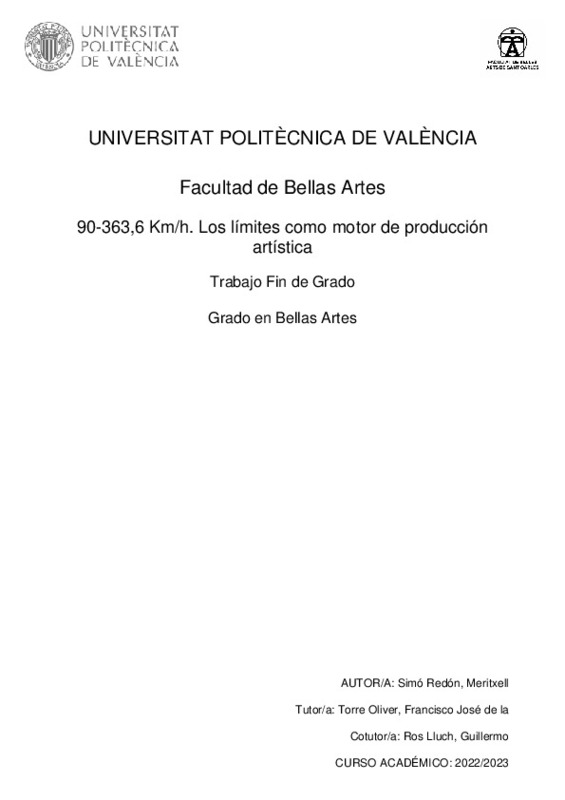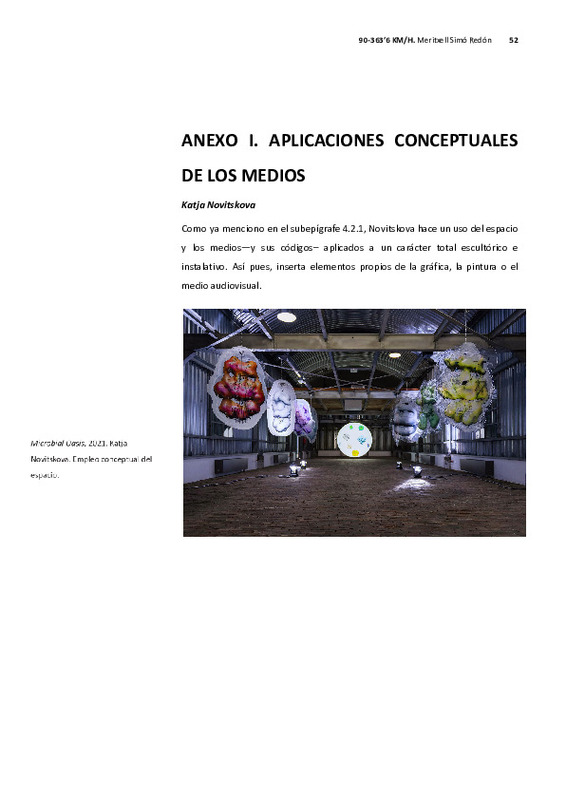JavaScript is disabled for your browser. Some features of this site may not work without it.
Buscar en RiuNet
Listar
Mi cuenta
Estadísticas
Ayuda RiuNet
Admin. UPV
90-363,6 Km/h. Los límites como motor de producción artística
Mostrar el registro sencillo del ítem
Ficheros en el ítem
| dc.contributor.advisor | Torre Oliver, Francisco José de la
|
es_ES |
| dc.contributor.advisor | Ros Lluch, Guillermo
|
es_ES |
| dc.contributor.author | Simó Redón, Meritxell
|
es_ES |
| dc.date.accessioned | 2023-07-24T13:02:23Z | |
| dc.date.available | 2023-07-24T13:02:23Z | |
| dc.date.created | 2023-07-12 | |
| dc.date.issued | 2023-07-24 | es_ES |
| dc.identifier.uri | http://hdl.handle.net/10251/195383 | |
| dc.description.abstract | [ES] Este Trabajo de Fin de Grado consiste en un estudio teórico-práctico en forma de divagaciones en torno a los aspectos influyentes en la producción y proceso artístico concebidos en forma de límites. Siendo en este caso aquellos en relación con el mercado y el propio medio artístico. La principal finalidad de este estudio radica en una reflexión en torno a ello, así como el posterior cuestionamiento y el posicionamiento contrario a dichos límites establecidos. Para realizar esta indagación, dividimos el trabajo en dos fases. Por un lado, un estudio teórico que se subdivide en dos partes. Primeramente, para analizar el desarrollo del medio artístico desde su concepción clásica haciendo referencia a los textos de Marshall McLuhan y Simón Marchán; introduciendo, seguidamente, la expansión del medio a través de los textos de Rosalind Krauss, así como la posterior aportación de una visión multidisciplinar o de hipermedio que plantea Eugeni Bonet. Para, a continuación, realizar una visión interdisciplinar en el propio estudio mediante las aportaciones de Jorge Wagensberg y finalmente sugerir un posible rumbo hacia una concepción no disciplinar¿postdisciplinar¿que plantea Frédéric Darbellay. Seguidamente, analizamos la influencia del mercado y sus exigencias productivas en la obra artística, asumiendo un rol precario por parte del propio artista; haciendo alusión al texto El tiburón de los 12 millones de dólares: La curiosa economía del arte contemporáneo y las casas de subastas (2009) de Dan Thompson, para analizar dicho sistema a través de los textos de Remedios Zafra, Paul Ardenne y Juan Martín Prada. Por otro lado, realizamos una selección de referentes prácticos que han influído en la producción debido a su concepción interdisciplinar del medio teniendo en cuenta aspectos tanto formales, como conceptuales y poéticos; tales como Katja Novitskova, Josep Maynou y Jordi Mitjà en lo material; Peter Fischli y David Weiss en lo conceptual; así como Richard Prince y el colectivo Something Must Break en lo conceptual-material. Finalmente, desarrollamos el estudio práctico a través de la concepción de un personaje o alter ego que oscila entre un gurú sectario y un piloto de carreras. Todo ello haciendo uso de la imaginería del mundo del motor, y más concretamente de la competición de motocicletas para desarrollar conceptos como la velocidad, la competición y el autoposicionamiento que sugiere el estudio en torno a las limitaciones ya mencionadas. Teniendo en cuenta las condiciones en las que se ha realizado el estudio, tales como la superación de ciertas asignaturas, los medios económicos, y el desarrollo del propio estudio; proponemos una pieza instalativa con la intención de realizar una producción de carácter interdisciplinar. | es_ES |
| dc.description.abstract | [EN] This Final Degree Project consists of a theoretical-practical study in the form of digressions on the influential aspects of the artistic production and process conceived in the form of limits. In this case, those concerning the market and the artistic medium itself. The primary purpose of this study lies in reflecting on this and the subsequent questioning and positioning against these established limits. In order to carry out this investigation, we divided the work into two phases. On the one hand, this theoretical study is subdivided into two parts. Firstly, to analyze the development of the artistic medium from its classical conception by referring to the texts of Marshall McLuhan and Simón Marchán; then, introducing the expansion of the medium through the texts of Rosalind Krauss, as well as the subsequent contribution of a multidisciplinary or hypermedia vision proposed by Eugeni Bonet. An interdisciplinary vision follows this study itself through the contributions of Jorge Wagensberg. Finally, we suggest a possible direction towards a non-disciplinary¿postdisciplinary¿ conception proposed by Frédéric Darbellay. Next, we analyze the influence of the market and its productive demands on the artistic work, assuming a precarious role on the part of the artist himself, alluding to the text The $12 Million Stuffed Shark: The Curious Economics of Contemporary Art by Dan Thompson, in order to analyze this system through the texts by Remedios Zafra, Paul Ardenne, and Juan Martín Prada. On the other hand, we made a selection of practical references that have influenced the production due to their interdisciplinary conception of the medium, taking into account formal, conceptual, and poetic aspects, such as Katja Novitskova, Josep Maynou, and Jordi Mitjà in the material aspect; Peter Fischli and David Weiss in the conceptual aspect; as well as Richard Prince and the Something Must Break collective in the conceptual-material aspect. Finally, we develop the practical study by conceiving a character or alter ego oscillating between a sectarian guru and a racing driver, using the imagery of the motor world, specifically motorbike racing, to develop concepts such as speed, competition, and self-positioning that suggest the study around the above mentioned limitations. Considering the conditions in which the study has been carried out, such as the passing of certain subjects, the economic means, and the development of the study itself, we propose an installation piece to make a production of an interdisciplinary nature. | es_ES |
| dc.format.extent | 51 | es_ES |
| dc.language | Español | es_ES |
| dc.publisher | Universitat Politècnica de València | es_ES |
| dc.rights | Reserva de todos los derechos | es_ES |
| dc.subject | Límites | es_ES |
| dc.subject | Medio | es_ES |
| dc.subject | Mercado | es_ES |
| dc.subject | Postdisciplinar | es_ES |
| dc.subject | Velocidad | es_ES |
| dc.subject | Competición | es_ES |
| dc.subject | Instalación. | es_ES |
| dc.subject | Limits | es_ES |
| dc.subject | Medium | es_ES |
| dc.subject | Market | es_ES |
| dc.subject | Postdisciplinary | es_ES |
| dc.subject | Speed | es_ES |
| dc.subject | Competition | es_ES |
| dc.subject | Installation. | es_ES |
| dc.subject.classification | PINTURA | es_ES |
| dc.subject.classification | ESCULTURA | es_ES |
| dc.subject.other | Grado en Bellas Artes-Grau en Belles arts | es_ES |
| dc.title | 90-363,6 Km/h. Los límites como motor de producción artística | es_ES |
| dc.title.alternative | 90-363,6Km/h.Limits as a driving force in Artistic production | es_ES |
| dc.title.alternative | 90-363,6Km/h. Els límits com a motor de producció artística | es_ES |
| dc.type | Proyecto/Trabajo fin de carrera/grado | es_ES |
| dc.rights.accessRights | Abierto | es_ES |
| dc.contributor.affiliation | Universitat Politècnica de València. Departamento de Pintura - Departament de Pintura | es_ES |
| dc.contributor.affiliation | Universitat Politècnica de València. Facultad de Bellas Artes - Facultat de Belles Arts | es_ES |
| dc.description.bibliographicCitation | Simó Redón, M. (2023). 90-363,6 Km/h. Los límites como motor de producción artística. Universitat Politècnica de València. http://hdl.handle.net/10251/195383 | es_ES |
| dc.description.accrualMethod | TFGM | es_ES |
| dc.relation.pasarela | TFGM\153899 | es_ES |
Este ítem aparece en la(s) siguiente(s) colección(ones)
-
BBAA - Trabajos académicos [4517]
Facultad de Bellas Artes







